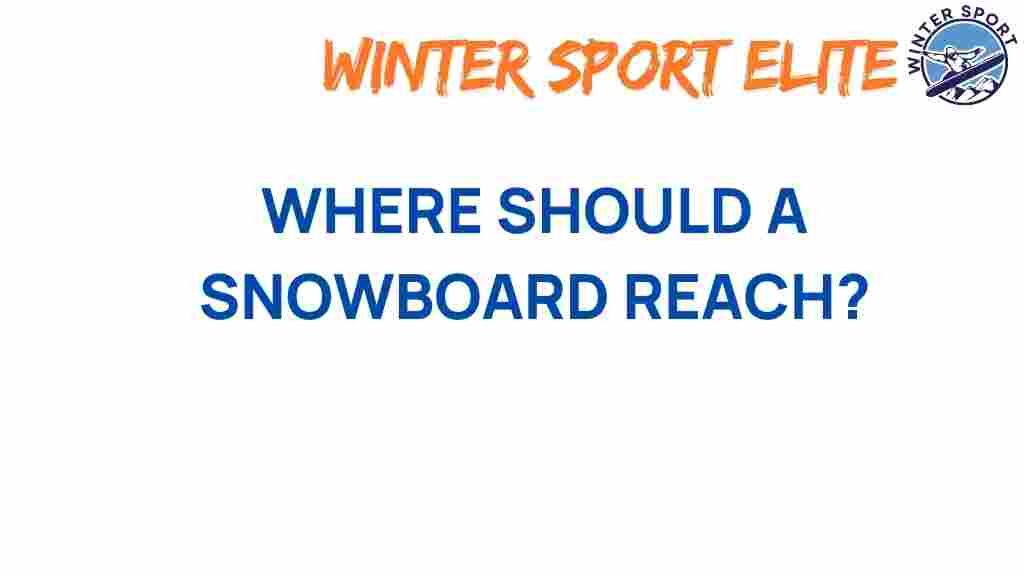The Ultimate Guide to Snowboard Length: Finding Your Perfect Fit
Choosing the right snowboard length is crucial for maximizing your performance and enjoyment on the slopes. Whether you’re a beginner just starting out or an experienced rider looking to upgrade your gear, understanding how snowboard length affects your ride is essential. In this ultimate guide, we’ll explore everything you need to know about snowboard sizing, including how rider height, skill level, and board types come into play. By the end of this article, you’ll be equipped with the knowledge to find your perfect fit.
Understanding Snowboard Length
Snowboard length is one of the most critical factors in choosing the right snowboard for your needs. It can greatly influence your performance, control, and overall riding experience. Snowboards come in various lengths, typically ranging from 140 cm to over 170 cm. The correct length for you depends on multiple factors, including:
- Rider Height: Taller riders generally need longer boards, while shorter riders benefit from shorter boards.
- Skill Level: Beginners may prefer shorter boards for easier maneuverability, while advanced riders often choose longer boards for stability at high speeds.
- Board Types: Different types of snowboards (freestyle, all-mountain, powder) have varying length recommendations.
Why Snowboard Length Matters
The length of your snowboard affects several performance aspects:
- Stability: Longer boards provide more stability at high speeds and on flat terrain.
- Maneuverability: Shorter boards are easier to turn and are more suitable for tricks and park riding.
- Floatation: In powder, longer boards tend to float better, while shorter boards may sink.
Step-by-Step Sizing Guide for Snowboards
Now that we understand the importance of snowboard length, let’s dive into a step-by-step guide to help you find your perfect fit.
Step 1: Measure Your Height
Your height is the first and most straightforward measurement to consider when selecting snowboard length. Generally, snowboards should stand between your chin and the top of your head when stood on their tails. To ensure accuracy, follow these steps:
- Stand straight against a wall.
- Mark your height on the wall and measure it in centimeters.
Step 2: Consider Your Weight
Weight plays a significant role in snowboard sizing. While height provides a general guideline, weight helps to refine your choice. Different boards are designed to support various weight ranges. Check the manufacturer’s weight recommendations for each snowboard model.
Step 3: Assess Your Skill Level
Your skill level is crucial in determining the best snowboard length for you:
- Beginner: Choose a shorter board for better control and easier turns.
- Intermediate: Opt for a board that allows you to progress, typically around your chin to nose height.
- Advanced: Longer boards may be more suitable for high speeds and aggressive riding.
Step 4: Choose Your Board Type
Different types of snowboards are optimized for various riding styles:
- Freestyle: Shorter boards (140-155 cm) for tricks and park riding.
- All-Mountain: Medium length (150-165 cm) for versatility across different terrains.
- Powder: Longer boards (160 cm and above) for better floatation in deep snow.
Step 5: Test Ride if Possible
Whenever possible, test different board lengths before making a purchase. Many shops offer rental options, allowing you to experience how different lengths feel on the snow.
Troubleshooting Common Snowboard Length Issues
Even with a proper sizing guide, you may still face issues with snowboard length. Here are some common problems and solutions:
Issue 1: Too Short of a Board
If your snowboard feels too short, you may experience:
- Difficulty maintaining speed.
- Lack of stability on flat terrain.
Solution: Consider upgrading to a longer board that fits your height and weight more appropriately.
Issue 2: Too Long of a Board
On the other hand, if your snowboard feels too long, you might notice:
- Difficulty turning and maneuvering.
- Excessive fatigue during rides.
Solution: A shorter board may provide the agility you need for a more enjoyable ride.
Issue 3: Wrong Board Type
Choosing the wrong board type can also lead to performance issues:
- Freestyle boards might feel unstable at high speeds.
- All-mountain boards may not provide the floatation needed in deep powder.
Solution: Make sure to select a snowboard that aligns with your intended riding style and conditions.
Conclusion: Finding Your Perfect Snowboard Length
Choosing the right snowboard length is essential for enhancing your snowboarding experience. By understanding the importance of rider height, weight, skill level, and board types, you can make an informed decision that will elevate your performance on the slopes. Remember to test ride when possible and consult with knowledgeable staff at your local snowboard shop for personalized advice.
For further reading on snowboarding gear and tips, check out this comprehensive guide. And if you’re looking for the latest snowboard models, visit this external resource to stay updated!
Happy shredding, and may your snowboard length be the perfect fit for your riding adventure!
This article is in the category Snowboarding and created by WinterSportElite Team
